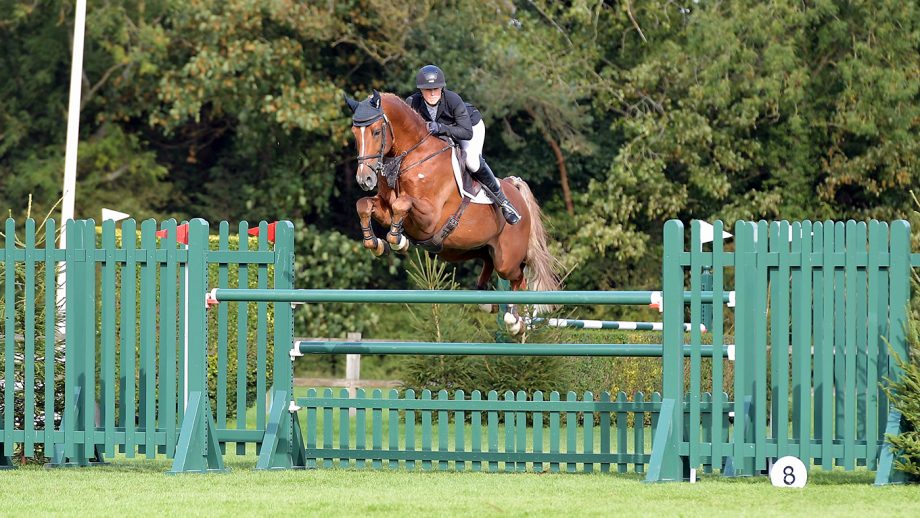Olympian Gemma Tattersall puts two event horses at different levels through a grid designed to teach them to jump both boldly and carefully
Gemma Tattersall shares with us a gridwork jumping exercise using V poles that was inspired by her friend and fellow event rider Laura Collett…
Gridwork is often known as gymnastic jumping, because it helps teach the horse to be more elastic and enables both horse and rider to hone certain techniques without fussing about the perfect stride. Grids are typically set up on slightly short strides – seven yards to a horse’s stride rather than eight – to encourage the horse to be sharp with his front legs and not flatten, instead making a rounded bascule over the fence with the forelegs tucked up. There are myriad grid formats you can set up, but in this session with two of Gemma’s event horses, she chooses one set out on “true striding”.
{"content":"PHA+4oCcVGhpcyBncmlkIGlzIGluc3BpcmVkIGJ5IG15IGZyaWVuZCBbQ0NJNSogd2lubmVyXSBMYXVyYSBDb2xsZXR0LCB3aG8gdXNlcyBpdCBzb21ldGltZXMgd2hlbiBzaGXigJlzIHNjaG9vbGluZyByYWNlaG9yc2VzLOKAnSBHZW1tYSBzYXlzLiDigJxJdOKAmXMgdXNlZnVsIGZvciBnZXR0aW5nIGhvcnNlcyB0byBiZSBtb3JlIGNhcmVmdWwgd2hlbiBqdW1waW5nIG91dCBvZiB0aGVpciBub3JtYWwgc3RyaWRlLjwvcD4KPHA+4oCcSGVhdnkgY2FudGVyIHBvbGVzIGFyZSBhIG11c3QgZm9yIHRoaXMs4oCdIHNoZSBhZGRzLiDigJxJIGFtIHRlYWNoaW5nIHRoZSBob3JzZSB0byBiZSBjYXJlZnVsIGJ5IGJlaW5nIGF3YXJlIG9mIHdoZXJlIHRoZXkgYXJlIHB1dHRpbmcgdGhlaXIgZmVldCDigJMgaWYgdGhleSBjYW7igJl0IGZlZWwgdGhlIHBvbGUsIHRoZXkgd29u4oCZdCBsZWFybi4gQW5kIGl04oCZcyBzYWZlciBiZWNhdXNlIHRoZXJlIGFyZSBxdWl0ZSBhIGZldyBwb2xlcyBvbiB0aGUgZ3JvdW5kIGluIHRoaXMgZXhlcmNpc2UgYW5kIGlmIHRoZXkgcm9sbCB1bmRlciB0aGUgaG9yc2XigJlzIGZvb3QsIHRoZXkgY2FuIHR1cm4gYW4gYW5rbGUuIEnigJltIGp1c3QgdXNpbmcgYmlnLCBoZWF2eSBwb2xlcywgYnV0IHlvdSBjYW4gYWxzbyByYWlzZSB0aGVtIG9uIGEgYnJpY2suPC9wPgo8cD7igJxFYWNoIGZlbmNlIGhhcyBhIHBsYWNpbmcgcG9sZSB0aHJlZSB5YXJkcyBpbiBmcm9udCwgd2hpY2ggdGVuZHMgdG8gbWFrZSB0aGUgaG9yc2UgZG8gYSBzbWFsbCBqdW1wIG92ZXIgdGhlIHBvbGUgb24gdGhlIGZpbmFsIHN0cmlkZSBiZWZvcmUgdGFraW5nIG9mZiBvdmVyIHRoZSBmZW5jZSwgd2hpY2ggZW5jb3VyYWdlcyB0aGVtIHRvIHBpY2sgdGhlaXIgZnJvbnQgbGVncyB1cC48L3A+CjxwPjxkaXYgY2xhc3M9ImFkLWNvbnRhaW5lciBhZC1jb250YWluZXItLW1vYmlsZSI+PGRpdiBpZD0icG9zdC1pbmxpbmUtMiIgY2xhc3M9ImlwYy1hZHZlcnQiPjwvZGl2PjwvZGl2PjxzZWN0aW9uIGlkPSJlbWJlZF9jb2RlLTMxIiBjbGFzcz0iaGlkZGVuLW1kIGhpZGRlbi1sZyBzLWNvbnRhaW5lciBzdGlja3ktYW5jaG9yIGhpZGUtd2lkZ2V0LXRpdGxlIHdpZGdldF9lbWJlZF9jb2RlIHByZW1pdW1faW5saW5lXzIiPjxzZWN0aW9uIGNsYXNzPSJzLWNvbnRhaW5lciBsaXN0aW5nLS1zaW5nbGUgbGlzdGluZy0tc2luZ2xlLXNoYXJldGhyb3VnaCBpbWFnZS1hc3BlY3QtbGFuZHNjYXBlIGRlZmF1bHQgc2hhcmV0aHJvdWdoLWFkIHNoYXJldGhyb3VnaC1hZC1oaWRkZW4iPg0KICA8ZGl2IGNsYXNzPSJzLWNvbnRhaW5lcl9faW5uZXIiPg0KICAgIDx1bD4NCiAgICAgIDxsaSBpZD0ibmF0aXZlLWNvbnRlbnQtbW9iaWxlIiBjbGFzcz0ibGlzdGluZy1pdGVtIj4NCiAgICAgIDwvbGk+DQogICAgPC91bD4NCiAgPC9kaXY+DQo8L3NlY3Rpb24+PC9zZWN0aW9uPjwvcD4KPHA+4oCcVGhlIGRpc3RhbmNlcyBmb3IgdGhpcyBncmlkIGFyZSB0cnVlLCBiZWNhdXNlIEkgZG9u4oCZdCB3YW50IHRoZSBob3JzZSBiYWNraW5nIG9mZiB0b28gbXVjaC4gSXQgaXMgZGVzaWduZWQgdG8gbWFrZSB0aGVtIHNpdCBiYWNrLCBqdW1wIHRoZSBwb2xlIGFuZCBzbmFwIHVwIGluIGZyb250LuKAnTwvcD4KPHA+PGltZyBmZXRjaHByaW9yaXR5PSJoaWdoIiBkZWNvZGluZz0iYXN5bmMiIGNsYXNzPSJsYXp5bG9hZCBibHVyLXVwIGFsaWdubm9uZSBzaXplLWZ1bGwgd3AtaW1hZ2UtNzM1OTU0IiBkYXRhLXByb2Nlc3NlZCBzcmM9Imh0dHBzOi8va2V5YXNzZXRzLnRpbWVpbmN1ay5uZXQvaW5zcGlyZXdwL2xpdmUvd3AtY29udGVudC91cGxvYWRzL3NpdGVzLzE0LzIwMTcvMDMvbmV3LWhoLXBsYWNlaG9sZGVyLTIwMHgyMDAucG5nIiBkYXRhLXNyYz0iaHR0cHM6Ly9rZXlhc3NldHMudGltZWluY3VrLm5ldC9pbnNwaXJld3AvbGl2ZS93cC1jb250ZW50L3VwbG9hZHMvc2l0ZXMvMTQvMjAyMS8wMS9nZW1tYS1kaWFncmFtLTEuanBnIiBhbHQ9IiIgd2lkdGg9IjI5NyIgaGVpZ2h0PSI0MzEiIGRhdGEtc2l6ZXM9ImF1dG8iIGRhdGEtc3Jjc2V0PSJodHRwczovL2tleWFzc2V0cy50aW1laW5jdWsubmV0L2luc3BpcmV3cC9saXZlL3dwLWNvbnRlbnQvdXBsb2Fkcy9zaXRlcy8xNC8yMDIxLzAxL2dlbW1hLWRpYWdyYW0tMS5qcGcgMjk3dywgaHR0cHM6Ly9rZXlhc3NldHMudGltZWluY3VrLm5ldC9pbnNwaXJld3AvbGl2ZS93cC1jb250ZW50L3VwbG9hZHMvc2l0ZXMvMTQvMjAyMS8wMS9nZW1tYS1kaWFncmFtLTEtMTM4eDIwMC5qcGcgMTM4dywgaHR0cHM6Ly9rZXlhc3NldHMudGltZWluY3VrLm5ldC9pbnNwaXJld3AvbGl2ZS93cC1jb250ZW50L3VwbG9hZHMvc2l0ZXMvMTQvMjAyMS8wMS9nZW1tYS1kaWFncmFtLTEtMjc2eDQwMC5qcGcgMjc2dywgaHR0cHM6Ly9rZXlhc3NldHMudGltZWluY3VrLm5ldC9pbnNwaXJld3AvbGl2ZS93cC1jb250ZW50L3VwbG9hZHMvc2l0ZXMvMTQvMjAyMS8wMS9nZW1tYS1kaWFncmFtLTEtNjl4MTAwLmpwZyA2OXcsIGh0dHBzOi8va2V5YXNzZXRzLnRpbWVpbmN1ay5uZXQvaW5zcGlyZXdwL2xpdmUvd3AtY29udGVudC91cGxvYWRzL3NpdGVzLzE0LzIwMjEvMDEvZ2VtbWEtZGlhZ3JhbS0xLTIyMXgzMjAuanBnIDIyMXciIHNpemVzPSIobWF4LXdpZHRoOiAyOTdweCkgMTAwdncsIDI5N3B4IiAvPjwvcD4KPHA+R2VtbWEgZmlyc3QgYnJpbmdzIG91dCBvbmUgb2YgaGVyIHRvcCBldmVudGVycywgU2FudGlhZ28gQmF5IChLaXp6eSksIGFuZCB3YXJtcyBoZXIgdXAgZm9yIDEwIHRvIDE1IG1pbnV0ZXMgaW4gd2FsaywgdHJvdCBhbmQgY2FudGVyLiBTaGUgaW5jb3Jwb3JhdGVzIHRyYW5zaXRpb25zLCBmbHlpbmcgY2hhbmdlcyBhbmQgZW5zdXJlcyB0aGUgbWFyZSBpcyBsaXN0ZW5pbmcgdG8gaGVyIGFpZHMuPC9wPgo8ZGl2IGNsYXNzPSJhZC1jb250YWluZXIgYWQtY29udGFpbmVyLS1tb2JpbGUiPjxkaXYgaWQ9InBvc3QtaW5saW5lLTMiIGNsYXNzPSJpcGMtYWR2ZXJ0Ij48L2Rpdj48L2Rpdj4KPHA+QWZ0ZXIgY2FudGVyaW5nIGRvd24gdGhlIGxpbmUgd2l0aCB0aGUgcG9sZXMgb24gdGhlIGdyb3VuZCwgdG8gZmFtaWxpYXJpc2UgS2l6enkgd2l0aCB0aGUgdGFzayBpbiBoYW5kLCBHZW1tYSBzaG93cyBoZXIgdGhlIGZpcnN0IGZlbmNlLjwvcD4KPHA+4oCcU2hlIGNhbiBiZSBhIG1vbmtleSBhdCB0aGUgZmlyc3QsIHNvIEkgYWx3YXlzIHNob3cgaGVyIGl0IGJlZm9yZSB3ZSBzdGFydCBqdW1waW5nLOKAnSBHZW1tYSBleHBsYWlucy4g4oCcSXTigJlzIGhlciBxdWlyaywgYnV0IEkgZG9u4oCZdCBsZXQgaXQgYm90aGVyIG1lLiBTaGXigJlzIGFuIGFtYXppbmcgc2hvd2p1bXBlciBhbmQgaGFzIHJlYWwgZmlnaHQgYWJvdXQgaGVyOyBpdOKAmXMgd2hhdCBtYWtlcyBoZXIgc28gZ29vZC4gQnV0IHNoZSBjYW4gYmUgc3Bvb2t5LCBldmVuIGluIHRoZSBzY2hvb2wu4oCdPC9wPgo8ZGl2IGNsYXNzPSJhZC1jb250YWluZXIgYWQtY29udGFpbmVyLS1tb2JpbGUiPjxkaXYgaWQ9InBvc3QtaW5saW5lLTQiIGNsYXNzPSJpcGMtYWR2ZXJ0Ij48L2Rpdj48L2Rpdj4KPHA+R2VtbWEgYnVpbGRzIHVwIHRoZSBncmlkIGZlbmNlIGJ5IGZlbmNlLCBzdGFydGluZyB3aXRoIGEgMmZ0IDlpbiB2ZXJ0aWNhbC4gU2hlIGhhcyBhIGhlbHBlciDigJMgaGVyIGhlYWQgZ3Jvb20gQ2hhcmxvdHRlIE92ZXJ0b24g4oCTIG9uIHRoZSBncm91bmQgdG8gYWRqdXN0IHRoZSBmZW5jZXMgc28gdGhhdCBzaGUgY2FuIGtlZXAgY29taW5nIG9mZiBib3RoIHJlaW5zLCB3aXRoIGEgZmVuY2UgYWRkZWQgZWFjaCB0aW1lIHNoZSBjb21wbGV0ZXMgdGhlIGxpbmUuIFRoZSBncmlkIGJ1aWxkcyB1cCByYXBpZGx5IGludG8gYSB2ZXJ0aWNhbCB0byB0d28gb3hlcnMgYW5kIGZpbmFsbHkgYSB2ZXJ0aWNhbC4gQWx0aG91Z2ggR2VtbWEgaGFzIGEgMjB4NjBtIGFyZW5hLCBzaGUgc2F5cyBpdCB3b3VsZCBiZSBkb2FibGUgaW4gYSBzaG9ydCBhcmVuYSB3aXRoIGp1c3QgdGhyZWUgZmVuY2VzIHJhdGhlciB0aGFuIGZvdXIuPC9wPgo8cD5FYWNoIGZlbmNlIGhhcyBWLXBvbGVzIHJlc3Rpbmcgb24gdGhlIGZlbmNlIHdoaWNoLCB0b2dldGhlciB3aXRoIHRoZSBwbGFjaW5nIHBvbGUsIGdpdmUgdGhlIGhvcnNlIGEgbG90IHRvIHRha2UgaW4gdmlzdWFsbHkgYW5kIGFzc2VzcyB3aGF0IHRvIGRvIHdpdGggdGhlaXIgZmVldC4gSG93ZXZlciwgR2VtbWEgZG9lc27igJl0IHVzZSBleHRyYSBwb2xlcyB1bmRlcm5lYXRoIHRoZSB0b3AgYmFyLCB0byB0ZWFjaCBob3JzZXMgdGhhdOKAmXMgdGhlIGhlaWdodCB0byB3b3JyeSBhYm91dC4gS2l6enkgcGVyZm9ybXMgZXhhY3RseSBhcyByZXF1aXJlZCwgY2FudGVyaW5nIGluIHN0cm9uZ2x5IGFuZCBiYXNjdWxpbmcgYmVhdXRpZnVsbHkuPC9wPgo8ZGl2IGNsYXNzPSJhZC1jb250YWluZXIgYWQtY29udGFpbmVyLS1tb2JpbGUiPjxkaXYgaWQ9InBvc3QtaW5saW5lLTUiIGNsYXNzPSJpcGMtYWR2ZXJ0Ij48L2Rpdj48L2Rpdj4KPHA+4oCcSeKAmW0gbW92aW5nIHVwIHF1aWNrbHkgd2l0aCBoZXIgYmVjYXVzZSBzaGXigJlzIGEgZml2ZS1zdGFyIGhvcnNlIGFuZCBzaGUga25vd3MgdGhlIGV4ZXJjaXNlOyB0aGlzIHdpbGwganVzdCBzaGFycGVuIGhlciB1cCzigJ0gc2F5cyBHZW1tYS4g4oCcVGhlIGZpcnN0IHRpbWUgeW91IGRvIHRoaXMsIHlvdSBzaG91bGQgc3RhcnQgc21hbGwgYmVjYXVzZSBpdCB0YWtlcyBob3JzZXMgYSBiaXQgb2YgZ2V0dGluZyB1c2VkIHRvLuKAnTwvcD4KPHA+VGhlIHRydWUgZGlzdGFuY2VzIGJldHdlZW4gZmVuY2VzLCBjb21iaW5lZCB3aXRoIHRoZSBwbGFjaW5nIHBvbGVzIHRoZSBob3JzZSBuZWVkcyB0byBuZWdvdGlhdGUsIGFyZSB0aGUgZXNzZW5jZSBvZiB0aGlzIGdyaWQuPC9wPgo8cD7igJxJdOKAmXMgYSBtaXggb2YgdGVhY2hpbmcgdGhlIGhvcnNlIHRvIGJlIGNhcmVmdWwgYW5kIHN0YXlpbmcgb24gYSBuYXR1cmFsIGZvcndhcmQgc3RyaWRlLOKAnSBzYXlzIEdlbW1hLiDigJxZb3UgaGF2ZSB0byBiZSBicmF2ZSBhbmQga2VlcCBjb21pbmcgYXQgdGhlIGZlbmNlcywgYnV0IGxldCB0aGUgZ3JpZCBkbyB0aGUgd29yay4gSXQgaGVscHMgdGhlIGhvcnNlIHNuYXAgb3V0IG9mIGFuIG9ud2FyZCBzdHJpZGUuIElmIHlvdeKAmXZlIGdvdCBvbmUgdGhhdCBkYW5nbGVzIGl0cyBsZWdzIG9yIGRvZXNu4oCZdCBsaWZ0IHRoZSBzaG91bGRlciwgdGhpcyBpcyBhIGdyZWF0IGV4ZXJjaXNlLuKAnTwvcD4KPHA+S2l6enkgaXMgbm93IGp1bXBpbmcgNGZ0IGFzIHRoZSBmaW5hbCBmZW5jZSwgYW5kIGdpdmVzIG9uZSBvZiB0aGUgVi1wb2xlcyBhIHNsaWdodCB0YXAuPC9wPgo8cD7igJxUaGUgZ3JpZCBkcmV3IHRoYXQgbWlzdGFrZSBvdXQgb2YgaGVyOyBzaGUgd2FzIGJsYXPDqSBhbmQgc2hl4oCZbGwgbGVhcm4gZnJvbSB0aGF0LOKAnSBHZW1tYSBzYXlzLCBhc2tpbmcgQ2hhcmxvdHRlIHRvIHdpZGVuIHRoZSBnYXAgYmV0d2VlbiB0aGUgVi1wb2xlcyBzbGlnaHRseSBmb3IgdGhlIG5leHQgYXR0ZW1wdCDigJMgd2hpY2ggc2hlIGp1bXBzIHBlcmZlY3RseS4g4oCcWW91IGhhdmUgdG8gcmVhZCB5b3VyIGhvcnNlIGFuZCByZWFjdCBlYWNoIHRpbWUgdG8gd2hhdCB0aGV5IG5lZWQgYW5kIHdoZXRoZXIgdG8gYWRqdXN0IHRoZSBWcy4gSWYgeW91IGhhdmUgYSBob3JzZSB3aG8gaXMgd29ycmllZCBhYm91dCB0aGVtLCBwb3NpdGlvbiB0aGVtIHdpZGVyIGluaXRpYWxseSBhbmQgZ3JhZHVhbGx5IGJyaW5nIHRoZW0gaW4uPC9wPgo8cD7igJxJIGtuZXcgS2l6enkgd291bGQgYmUgc2hhcnAgZW5vdWdoIHNlY29uZCB0aW1lLCBzbyBJIHdpZGVuZWQgdGhlIFZzIHRvIGVuY291cmFnZSBoZXIgYW5kIHNoZSB3YXMgc3VwZXItY2FyZWZ1bCDigJMgc28gSeKAmWxsIGxlYXZlIGl0IGF0IHRoYXQuIEl04oCZcyBpbXBvcnRhbnQgbm90IHRvIG92ZXJkbyBpdCBhbmQgZmluaXNoIHRoZSBzZXNzaW9uIHdpdGggdGhlbSBmZWVsaW5nIGhhcHB5LuKAnTwvcD4KPGgzPlVzaW5nIHRoZSBleGVyY2lzZSBmb3IgYSBsZXNzIGV4cGVyaWVuY2VkIGhvcnNlPC9oMz4KPHA+R2VtbWHigJlzIHNlY29uZCByaWRlIG9mIHRoZSBkYXkgaXMgYSB0b3RhbGx5IGRpZmZlcmVudCBwcm9zcGVjdCDigJMgQ2hpbGxpIFJvY2tzLCBhIGdhbmdseSByaXNpbmcgc2l4LXllYXItb2xkIGdlbGRpbmcuIEdlbW1hIGxhdWdocyBhcyBzaGUgd29ya3MgaGltIGluLCBoYXZpbmcgc3dhcHBlZCBmcm9tIGEgaGlnaGx5IHR1bmVkIGFkdmFuY2VkIHJpZGUgdG8gYSBiYWJ5IGp1c3QgZmluZGluZyBoaXMgZmVldC48L3A+CjxwPuKAnEhl4oCZcyBoaWxhcmlvdXMsIGxlZ3MgZXZlcnl3aGVyZSzigJ0gc2hlIHNheXMuIOKAnEhl4oCZcyB2ZXJ5IGdyZWVuLiBDaGlsbGkgTW9ybmluZ+KAmXMgZm9hbHMgdGVuZCB0byBiZSBsYXRlIGRldmVsb3BlcnMgYW5kIGJhYnlpc2ggc28geW91IGRvbuKAmXQgcHVzaCB0aGVtIGVhcmx5LiBUaGV5IG9ubHkgYmVjb21lIOKAmHdvdyBob3JzZXPigJkgd2hlbiB0aGV5IGFyZSBvbGRlci7igJ08L3A+CjxwPlJvY2t54oCZcyBpbmV4cGVyaWVuY2UgZG9lc27igJl0IGhvbGQgaGltIGJhY2sgZnJvbSBzY2hvb2xpbmcgdGhyb3VnaCB0aGUgc2FtZSBncmlkIGFzIGhpcyBzZW5pb3Igc3RhYmxlbWF0ZSwgaG93ZXZlci4gR2VtbWEgc2ltcGx5IGJ1aWxkcyB1cCBtdWNoIG1vcmUgZ3JhZHVhbGx5IHRoYW4gd2l0aCBLaXp6eSwgYW5kIGtlZXBzIHRoZSBqdW1wcyByZWxhdGl2ZWx5IGxvdy48L3A+CjxwPuKAnFdpdGggYSB5b3VuZyBvbmUsIEkgY29tZSBpbiB0cm90IGluaXRpYWxseSBzbyB0aGV5IGxlYXJuIG5vdCB0byBqdW1wIHRoZSBmZW5jZSBhbmQgdGhlIHBsYWNpbmcgcG9sZSBpbiBvbmUgZ28g4oCTIEnigJl2ZSBoYWQgYSBmZXcgZG8gdGhhdCHigJ0gc2hlIHNheXMsIHRyb3R0aW5nIHF1aWV0bHkgdGhyb3VnaCB0aGUgbGluZSBhIGZldyB0aW1lcyB3aXRoIHRoZSBwb2xlcyBvbiB0aGUgZ3JvdW5kLjwvcD4KPHA+TmV4dCBzaGUgYWRkcyBpbiB0aGUgZmlyc3QgdmVydGljYWwgYW5kIGFnYWluIHJlcGVhdHMsIHJhdGhlciB0aGFuIG1vdmluZyBzdHJhaWdodCBpbnRvIGFkZGluZyBleHRyYSBmZW5jZXMuPC9wPgo8cD7igJxIZSBqdW1wcyBpbiBzbG93IG1vdGlvbizigJ0gc2hlIGdyaW5zLCBhcyBSb2NreSBjYXJlZnVsbHkgd29ya3MgaGlzIHdheSB0aHJvdWdoIHRoZSBncmlkLiDigJxIZSBoYXMgdG8gbGVhcm4gdG8gaGF2ZSBxdWlja2VyIHJlYWN0aW9ucywgYnV0IGhl4oCZcyBzZWVpbmcgd2hlcmUgaGUgaXMgbG9uZyBhbmQgaGUgcmVhbGx5IHRyaWVzLuKAnTwvcD4KPHA+R2VtbWEgcGxheXMgYWJvdXQgYSBiaXQgd2l0aCB0aGUgVi1wb2xlcywgZmlyc3QgcHVsbGluZyB0aGVtIHRvZ2V0aGVyIHRvIHRlYWNoIGhpbSB0byBiZSBtb3JlIGNhcmVmdWwgYW5kIHRoZW4gd2lkZW5pbmcgdGhlbSB0byBnaXZlIGhpbSB0aGUgY29uZmlkZW5jZSB0byBqdW1wIHRocm91Z2guIEFmdGVyIHRocmVlIGdvZXMgb2YgdGhlIGZ1bGwgc2VxdWVuY2UsIEdlbW1hIHNlbnNlcyBoZeKAmXMgZG9uZSBlbm91Z2ggZm9yIG9uZSBzZXNzaW9uLjwvcD4KPHA+4oCcQWx3YXlzIGVuZCBvbiBhIGdvb2Qgbm90ZSDigJMgYW5kIGhl4oCZcyBtYWRlIGEgZ29vZCBlZmZvcnQgdG9kYXks4oCdIHNoZSBzYXlzLiDigJxUaGlzIGlzIGEgaGFyZCBleGVyY2lzZSBhbmQgcmVhbGx5IG1ha2VzIHRoZW0gd29yay7igJ08L3A+CjxwPldoaWxlIFJvY2t5IGhhc27igJl0IHB1dCBhIGZvb3Qgd3JvbmcsIEdlbW1hIGhhcyBzb21lIGFkdmljZSBmb3IgZ3JlZW4gaG9yc2VzIGlmIHRoZXkgYXJlIHN0cnVnZ2xpbmcuPC9wPgo8cD7igJxJZiB0aGV5IGtlZXAga25vY2tpbmcgZmVuY2VzLCBzb21ldGltZXMgaXTigJlzIHJpZ2h0IHRvIHN0b3AgYW5kIGNvbWUgYmFjayB0aGUgbmV4dCBkYXkgYW5kIHRyeSBhZ2FpbizigJ0gc2hlIHNheXMuIOKAnEl04oCZcyBhbWF6aW5nIGhvdyBob3JzZXMgc2VlbSB0byBhYnNvcmIgd2hhdCB0aGV54oCZdmUgYmVlbiB0YXVnaHQgb3Zlcm5pZ2h0LuKAnTwvcD4KPGgzPlRoZSB0cmFpbmVyPC9oMz4KPHA+PGEgaHJlZj0iL3RhZy9nZW1tYS10YXR0ZXJzYWxsIj5HZW1tYSBUYXR0ZXJzYWxsPC9hPiBpcyBhbiBPbHltcGljIGV2ZW50IHJpZGVyIHdobyBjb21wZXRlZCBhdCBSaW8gaW4gMjAxNiBvbiBRdWlja2xvb2sgViBhbmQgd29uIHRlYW0gZ29sZCBhdCB0aGUgV29ybGQgRXF1ZXN0cmlhbiBHYW1lcyBpbiAyMDE4IHdpdGggdGhlIHBvcHVsYXIgQXJjdGljIFNvdWwuIFNoZSBoYXMgYmVlbiA8YSBocmVmPSIvdGFnL2V2ZW50LXJpZGVyLW1hc3RlcnMiPkV2ZW50IFJpZGVyIE1hc3RlcnM8L2E+IGNoYW1waW9uLCBCcml0aXNoIG9wZW4gY2hhbXBpb24gYW5kIGZpbmlzaGVkIHRoaXJkIGF0IGJvdGggPGEgaHJlZj0iL3RhZy9iYWRtaW50b24taG9yc2UtdHJpYWxzIj5CYWRtaW50b248L2E+IGFuZCA8YSBocmVmPSIvdGFnL2J1cmdobGV5LWhvcnNlLXRyaWFscyI+QnVyZ2hsZXk8L2E+LiBHZW1tYSBhbHNvIGNvbXBldGVzIGluIGludGVybmF0aW9uYWwgc2hvd2p1bXBpbmcgYW5kIGp1bXBlZCBvbiB0aGUgUG9ydHVndWVzZSBTdW5zaGluZSBUb3VyIGluIHRoZSBhdXR1bW4uPC9wPgo8aDM+VGhlIGhvcnNlcyBkb2luZyBncmlkd29yayB3aXRoIFYgcG9sZXM8L2gzPgo8ZGl2IGNsYXNzPSJpbmplY3Rpb24iPjwvZGl2Pgo8cD5TYW50aWFnbyBCYXkgKHBpY3R1cmVkKSwgYSAxNi4xaGggbWFyZSBieSBBcnMgVml2ZW5kaSBvdXQgb2YgWmFudHVzIChBbGRhdHVzIFopLCBpcyByaXNpbmcgMTMuIFNoZSB3b24gdHdvIENDSTQqLVNzIGxhc3Qgc2Vhc29uIGFuZCB3YXMgc2V2ZW50aCBhdCBCdXJnaGxleSBDQ0k1KiBpbiAyMDE5LiDigJxLaXp6eeKAnSBpcyBvd25lZCBieSBDYXJvbGluZSBUZWx0c2NoIGFuZCB3aWxsIGJlIGFpbWVkIGZvciB0b3AgbGV2ZWwgZXZlbnRzIGFnYWluIHRoaXMgeWVhci48L3A+CjxwPkNoaWxsaSBSb2NrcywgYSAxNi4zaGggZ2VsZGluZyBieSBDaGlsbGkgTW9ybmluZyBvdXQgb2YgR2VtbWHigJlzIE9seW1waWMgcmlkZSBRdWlja2xvb2sgViAoVXJrZWwpLCBpcyByaXNpbmcgc2l4LiDigJxSb2NreeKAnSBpcyBvd25lZCBieSBDaHJpcyBhbmQgTGlzYSBTdG9uZSBhbmQgaGFzIGJlZW4gY29tcGV0aW5nIGluIHlvdW5nIGhvcnNlIHNob3dqdW1waW5nIGNsYXNzZXMsIGJ1dCBpcyBkZXN0aW5lZCB0byBiZSBhbiBldmVudGVyLjwvcD4KPHA+PGVtPlJlZjogMjEgSmFudWFyeSAyMDIxPC9lbT48L3A+CjxwPgo="}
You might also be interested in…
Credit: Spidge Photography
The international showjumper talks us through this multi-fence workout which she uses with both her younger and more experienced horses
Credit: Peter Nixon
The eventer provides an exercise she uses to help
her horses make a better shape over a fence
Credit: Tim Wilkinson
H&H features editor
Martha is an experienced journalist who is mad-keen on horses and dogs. Her reporting CV includes the Paris Olympics, European championships, Aachen World Equestrian Festival and World Cup finals. After growing up with assorted liver and white springer spaniels, she enjoyed 14 years with two rescue dogs. Now, her constant companion is Fidget, an extremely energetic and habitually muddy black and white springer. Martha has written on topics as diverse as a top horse’s clone to the best GPS trackers for dogs, as well as equestrian and rural matters for Country Life, The Field, The Times, The Spectator and The Telegraph alongside Horse & Hound .





